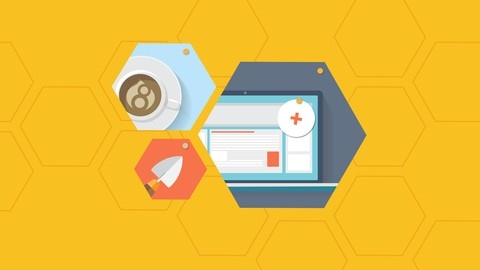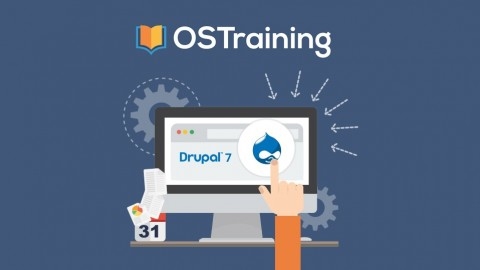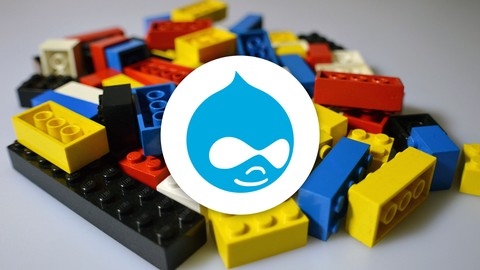Drupal is a powerful open-source content management system (CMS) known for its flexibility and customization capabilities.
With Drupal, you can build anything from simple websites and blogs to complex online communities and e-commerce platforms.
Learning Drupal opens doors to exciting opportunities in web development, allowing you to create dynamic and engaging digital experiences.
Finding the right Drupal course on Udemy, however, can be a challenging task, with so many options vying for your attention.
You’re looking for a course that’s comprehensive, engaging, and taught by experts, but also fits your learning style and goals.
We’ve meticulously reviewed countless Drupal courses on Udemy and, based on our analysis, we recommend DRUPAL TUTORIAL: Drupal 8 Beginner to Advanced in 8 PROJECTS as the best course overall.
This comprehensive program offers a hands-on, project-based learning experience that takes you from beginner to advanced, covering everything from fundamental concepts to real-world applications.
The instructor guides you through eight practical projects, building a solid foundation in Drupal 8 development while providing you with the skills and experience to tackle real-world challenges.
While DRUPAL TUTORIAL: Drupal 8 Beginner to Advanced in 8 PROJECTS is our top pick, there are other great Drupal courses available on Udemy.
Keep reading to explore our recommendations for different learning styles and goals, including courses focused on Drupal 9, specific modules, and specialized development techniques.
DRUPAL TUTORIAL: Drupal 8 Beginner to Advanced in 8 PROJECTS
You’ll start with an introduction to content management systems (CMS) and Drupal, learning when to use it and when not to.
The first project is a beginner-level company brochure website, where you’ll get familiar with Drupal’s interface and core features like adding pages, changing appearance, and creating contact forms.
Next, you’ll dive into content management essentials like content types, versioning, and bulk operations.
You’ll apply this knowledge by building a blog site, learning about design elements and user management along the way.
The course then covers more advanced topics like creating an internet forum with custom content workflows.
You’ll explore powerful theming capabilities in Drupal, learning how to install, customize, and choose themes for different use cases.
Taxonomy, one of Drupal’s powerful features, is covered through a recipe website project that utilizes vocabularies and term organization.
You’ll learn to create custom content types for a film review site, mastering fields, formatting, and content modeling.
The magic of Drupal blocks is demystified as you build a news magazine website, placing content strategically using core blocks, menus, and custom block types.
Block visibility controls are also covered.
A comprehensive module section explains core vs. contributed modules, evaluating third-party modules, installation, configuration, and upgrade/uninstall processes.
This knowledge is applied to an advanced eCommerce site project using the UberCart module.
Finally, you’ll learn about Views, Drupal’s query builder tool, exploring existing core views and building custom views for filtering and displaying content.
Learn Drupal 8 module development with examples
The course starts by guiding you through installing Drupal and setting up your development environment.
You’ll learn how to activate error messages, making it easier to debug issues during development.
From there, the course dives into the core concepts of Drupal module development.
You will learn how to declare and activate your own custom module.
The instructor will walk you through creating a controller and defining routes in the routing.yml file, allowing you to map URLs to your controller methods.
One key aspect covered is extending the ControllerBase class, which provides useful functionality for your controllers.
You’ll also learn how to create custom Twig templates and add libraries to your module.
The course covers essential Drupal components like blocks, forms, and configuration management.
You’ll build example hero blocks and renderable arrays within blocks.
For forms, you’ll create a custom form, add custom form elements, and learn how to alter any form using a hook.
Services and dependency injection are crucial concepts in Drupal 8, and this course dedicates sections to understanding them.
You’ll create a custom service, inject it into your controller, and practice injecting the current_user service.
Permissions are an important part of Drupal development, and the course teaches you how to declare and implement custom permissions.
You’ll restrict access to pages and parts of your module based on user permissions.
Beyond the basics, the course explores more advanced topics like hooks, events, and event subscribers.
You’ll learn how to implement custom hooks and find existing events to subscribe to.
The instructor also covers useful techniques like altering routes from a custom module and creating event subscribers.
Drupal For Absolute Beginners (2024)
The course starts by introducing you to Drupal and explaining why it’s a great choice for building websites.
You’ll then dive into setting up your local development environment by installing XAMPP and Drupal itself.
The course covers common issues like PHP extension errors to ensure a smooth setup process.
Once you have Drupal installed, you’ll get a tour of the admin toolbar and learn how to create and manage different types of content like basic pages and articles.
You’ll also learn about revisions, text formatting, and using images legally.
The course then moves on to user management, teaching you how to create new users, assign roles, and manage permissions.
This is crucial for building websites with different levels of access.
You’ll learn all about blocks in Drupal - what they are, how to use them, and how to control their visibility on different pages.
The course also covers URL aliases and menus, allowing you to create user-friendly URLs and navigation structures.
One of the most powerful aspects of Drupal is its module and theme ecosystem.
You’ll learn how to install and use modules like PathAuto for automatically generating URL aliases, and how to customize forms like the contact form.
You’ll also get experience installing and activating new themes to change your site’s appearance.
The course dives deep into content types, teaching you how to create custom types like “Offline Events” and manage their display.
You’ll even have an assignment to create your own content type, solidifying your understanding.
Throughout the course, you’ll work with essential Drupal concepts like localhost, the admin toolbar, user roles and permissions, blocks, menus, URL aliases, modules, themes, and content types.
Drupal 8 for Beginners
The course starts by introducing you to Drupal 8 and walking you through the installation process, including setting up MAMP and configuring the database.
Once you have Drupal 8 up and running, you’ll dive into building a solid foundation by learning about content types, modules, blocks, and contact forms.
The course covers views in-depth, teaching you how to set them up and work with contextual filters.
You’ll also learn about the REST-First approach for sending out data.
Theming is a crucial aspect of any website, and the course dedicates several lessons to working with Drupal 8 themes.
You’ll learn how to download and customize themes, including overriding templates and understanding the file and folder structure.
As you progress, you’ll gain hands-on experience by building a simple website from scratch.
This includes setting up content types, creating roles and permissions, setting up news feed views, adding an RSS view feed and a recent news block, and integrating a contact form.
The course even covers setting up a REST API for your website.
For those interested in extending Drupal 8’s functionality, the course teaches you how to build custom modules.
You’ll learn about naming conventions, creating a composer file and an info file, and adding functionality to your module.
The course also covers additional files and folders you might encounter.
Throughout the course, you’ll work with essential Drupal 8 concepts like databases, modules, blocks, views, contextual filters, themes, roles, permissions, and more.
By the end, you’ll have a solid understanding of Drupal 8 and the skills to build and manage your own websites.
Learning Drupal 8
The course covers everything you need to know about building websites with Drupal 8, from installation to deployment.
You’ll start by learning how to install Drupal locally or on an online service.
The course guides you through the core files, directory structure, and the installation process step-by-step.
Once Drupal is set up, you’ll dive into creating basic content like pages and articles, configuring site settings, and managing files and languages.
As you progress, you’ll learn about fundamental Drupal concepts like entities, nodes, blocks, and menus.
You’ll create custom content types like events with fields for telephone numbers and dates.
The course teaches you how to display this content using Views, a powerful tool for creating listings and filtering content.
To enhance your site’s functionality, you’ll explore core and contributed modules like the Forum module.
You’ll also learn about text formats, WYSIWYG editors like CKEditor, and media handling with image styles and responsive images.
Taxonomy, an essential part of content organization, is covered in-depth.
You’ll create vocabularies and associate them with content types, enabling you to build a recipe database with filtering capabilities using Views’ exposed and contextual filters.
User management is another crucial aspect, and you’ll learn about different user roles, permissions, and how to manage users effectively.
The course delves into theming, teaching you how to install and customize themes to achieve the desired look and feel for your site.
Finally, you’ll learn best practices for deploying and managing a Drupal site, including configuration management and security considerations.
Full introduction to Drupal 8 theming in easy steps
You’ll start by preparing your working environment and installing Drupal 8 using Acquia Dev Desktop.
The course then dives into the fundamentals of Drupal theming, covering topics like themes, theme folder structure, and installing existing themes from Drupal.org.
One of the key focuses is on understanding template files – where they are located and how to override them.
You’ll learn how to add your own markup and CSS/JS files to customize the theme’s appearance.
The course also covers essential concepts like view modes, node templates, page templates, and regions.
A significant portion is dedicated to the powerful Twig templating engine used in Drupal 8.
You’ll learn about Twig syntax, including loops, conditionals, filters, and functions.
The course shows you how to extend templates, create links, and handle translatable strings.
To solidify your learning, you’ll work on a subproject where you’ll convert a static website into a Drupal 8 theme.
This hands-on experience will reinforce the concepts you’ve learned and give you practical experience in implementing a real-world theme.
The course also covers advanced topics like preprocess functions, the Render API, and debugging techniques like using Kint.
You’ll learn how to leverage tools like the Chrome Twig extension and explore the capabilities of the .info file.
Additionally, there’s a bonus section that walks you through a second project step-by-step, further cementing your understanding of Drupal 8 theming.
Drupal 8 & 9 module development: start with custom entities
You’ll start by learning about content entities and their importance in Drupal’s architecture.
With this foundation, you’ll dive into building your first custom content entity from scratch.
The course covers securing access to these entities and implementing the essential create, edit, and delete (CRUD) operations.
Integration with Views, one of Drupal’s most powerful tools, is a key focus.
You’ll learn how to make your custom entities work seamlessly with Views for listing and filtering content.
Additionally, you’ll explore making your entities fieldable, allowing you to attach various types of fields like text, images, and more.
The course goes beyond the basics by covering advanced topics like media libraries and workflows.
You’ll learn how to add moderation states to your entities and change access based on these states.
Enhancing the user experience is also emphasized, with techniques like custom views fields, dropbuttons with actions, and optimizations using dynamic variables.
Importantly, the course teaches you how to build a user-friendly multistep form for creating entities, complete with custom actions and conditional fields powered by Drupal’s Form API.
This is a crucial skill for building intuitive content creation experiences.
Throughout the journey, you’ll also pick up valuable skills like adding a CSS library to your module and creating custom controllers with route parameter upcasting.
Full introduction to Views in Drupal 8
As a PHP Drupal Developer with over 7 years of experience, the instructor is well-equipped to teach you this powerful tool.
You’ll start by learning what Views is and how to navigate its interface.
The course covers editing the default Views that come bundled with Drupal, as well as creating new ones from scratch.
Through numerous examples, you’ll learn the basics and some advanced topics.
The course begins by setting up your local development environment using Acquia Dev Desktop, which includes Apache, MySQL, and PHP.
You’ll install Drupal with just a few clicks, providing the perfect playground to learn Views.
Next, you’ll dive into basic Views concepts like understanding Drupal entities (Nodes, Users, Taxonomy terms), the different View types (Pages, Blocks, etc.), and formatting options like tables, lists, grids, and content teasers.
You’ll master filters for narrowing results, sorting, pagers for pagination, and customizing headers and footers.
The advanced section covers crucial topics like user access control with roles and permissions, contextual filters for dynamic Views, and relationships to incorporate data from other entities.
You’ll learn to enhance the user experience with AJAX filters and pagination, caching for performance, and housekeeping tips.
Hands-on examples reinforce the concepts, such as creating a Page View, placing a Block View, using an Attachment View, and an Entity Reference View to display related nodes.
You’ll even build a complete front page with a content slider, article listings, and an archive.
The instructor covers popular third-party modules like Infinite Scroll, Better Exposed Filters, and Sliders, expanding your Views capabilities further.
Drupal 7 for Beginners
You’ll start by learning what Drupal is and how to install it, either manually or with a one-click installer.
Once you have Drupal set up, you’ll dive into creating different types of content like articles and basic pages.
The course covers adding revisions and formatting fields, as well as working with taxonomies to organize your content.
From there, you’ll learn how to extend Drupal’s functionality with modules.
The syllabus highlights several useful modules like Webform, AddToAny, and Site Map that you’ll get hands-on experience with.
Customizing your site’s design is also covered, including applying and installing new themes.
You’ll work with blocks for laying out content and learn menu management.
The course doesn’t stop at content - you’ll also learn about managing people on your site, including setting up roles and permissions.
The Masquerade module is introduced for testing user roles.
Towards the end, you’ll put everything together by building a personal website project.
The course even touches on local installation using Dev Desktop on Mac and Windows.
You’ll gain practical experience with core Drupal concepts like content types, taxonomies, modules, themes, and user management.
Create, Update and Manage Your Own Website Using Drupal 7
You’ll start with the basics like logging in, changing the site name and slogan, and understanding the difference between articles and basic pages.
From there, you’ll dive into working with content - adding pages and articles, using the “sticky” feature, changing URL aliases, and managing commenting settings.
The course even shows you how to customize the default front page.
As you progress, you’ll learn about managing users, roles, and permissions - crucial for controlling access on your site.
You’ll also master working with blocks and menus, allowing you to organize and display content effectively.
One key area is editing and creating new content types.
You’ll learn how to add different field types, manage display settings, and create entirely new content types from scratch.
The course covers using taxonomies to classify content as well.
For taking your site to the next level, you’ll explore modules - both core Drupal modules and popular contributed ones like Views, Pathauto, and ShareThis.
You’ll even learn how to install and configure the SoundCloud module for embedding audio.
Customizing your site’s appearance is made easy with a section on configuring and installing new themes.
Finally, you’ll get a crash course on publishing your site using FTP.










